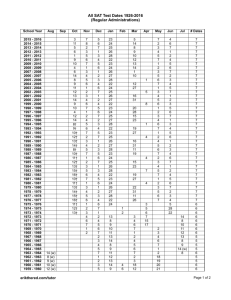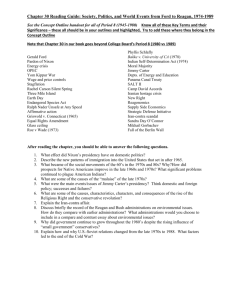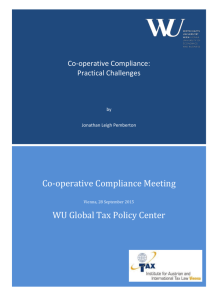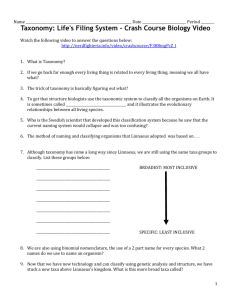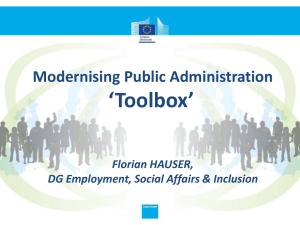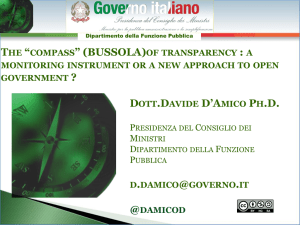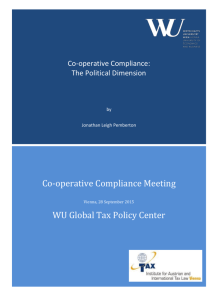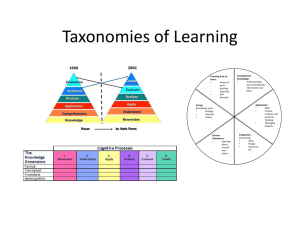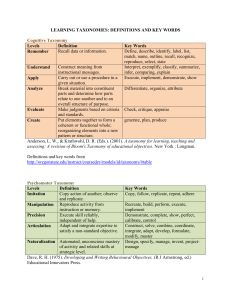Proposed Taxonomy for
advertisement
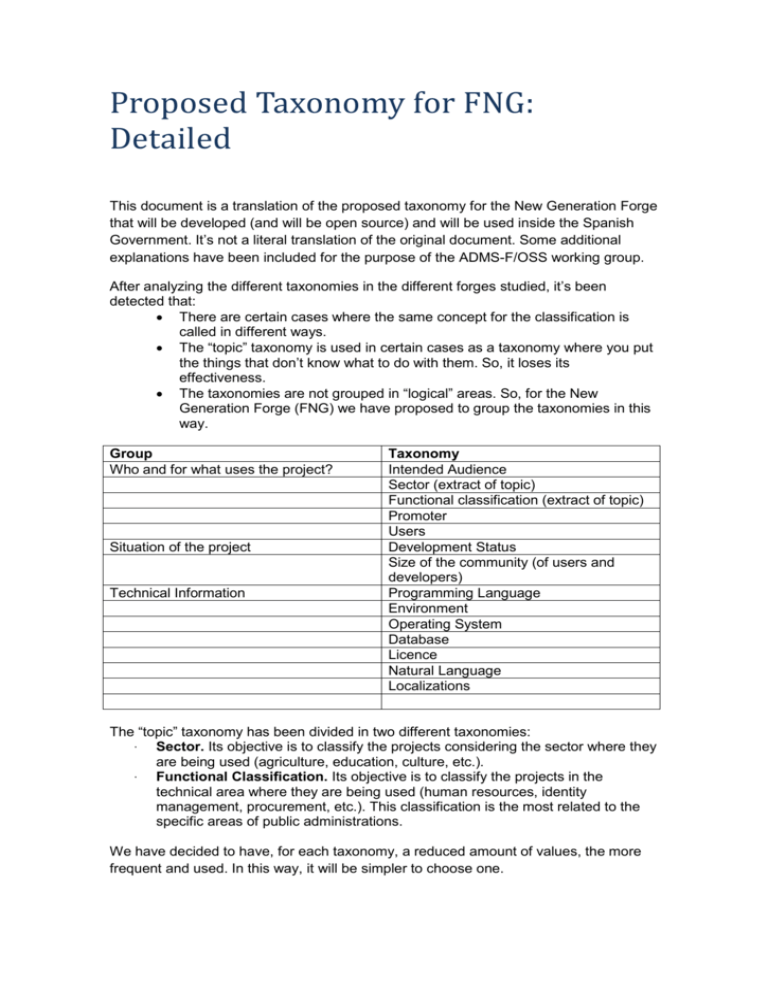
Proposed Taxonomy for FNG: Detailed This document is a translation of the proposed taxonomy for the New Generation Forge that will be developed (and will be open source) and will be used inside the Spanish Government. It’s not a literal translation of the original document. Some additional explanations have been included for the purpose of the ADMS-F/OSS working group. After analyzing the different taxonomies in the different forges studied, it’s been detected that: There are certain cases where the same concept for the classification is called in different ways. The “topic” taxonomy is used in certain cases as a taxonomy where you put the things that don’t know what to do with them. So, it loses its effectiveness. The taxonomies are not grouped in “logical” areas. So, for the New Generation Forge (FNG) we have proposed to group the taxonomies in this way. Group Who and for what uses the project? Situation of the project Technical Information Taxonomy Intended Audience Sector (extract of topic) Functional classification (extract of topic) Promoter Users Development Status Size of the community (of users and developers) Programming Language Environment Operating System Database Licence Natural Language Localizations The “topic” taxonomy has been divided in two different taxonomies: • Sector. Its objective is to classify the projects considering the sector where they are being used (agriculture, education, culture, etc.). • Functional Classification. Its objective is to classify the projects in the technical area where they are being used (human resources, identity management, procurement, etc.). This classification is the most related to the specific areas of public administrations. We have decided to have, for each taxonomy, a reduced amount of values, the more frequent and used. In this way, it will be simpler to choose one. 1. Who and for what is using the Project? a. Intended Audience It will consider the intended audience for reusing the software the Project. Some examples of values could be: Public Administrations o International o National o Regional o Local Citizens Enterprises Communities of developers b. Sector Its objective is to classify the projects considering the sector where they are being used. Some examples of values could be: Agriculture Telecommunications Transport Education Culture Etc We should consider sectors not directly related to Public Administrations (to make a general standard) but the forges of the public administrations should only have the items related with public administrations. For example in the TTC we have this classification: Personal documents Education Taxes, Pensions and Finantial Aids Environment Culture, Turism and Leissure Health, safety and Consumer Working Traffic and Transport Housing Companies Public Administration c. Functional Classification Its objective is to classify the projects in the technical area where they are being used. Some examples of values could be: Human Resources Identity management Procurement CRM Etc. We should consider areas not directely related to (or used inside) Public Administrations (to make a general standard) but the forges of the public administrations should only have the ítems related with public administrations. For example, in the TTC we have this classification: Examples Web sites and virtual offices Citizens Atention Web Tools Electronic Processing Support to Electronica Processing Management for internal Procedures Management of Finances Management of Human Resources Management of knowledge and support to taking decissions Infraestructure for Communications Infraestructure for Security Infraestructure for Messaging Infraesturcture for Managing Identities Services and Systems Management Development and running Platforms Desktop Environment Normatilzation and Regularization Common Services for Public Administrations Integrated offices, information phones, citizens folder, where is my tramit with the administration Searches, forum, georeferentation, etc The applications that perform the electronic processing such us registries, management of grants, etc. Products and services that makes possible the electronic management such us digital signature, interexchange of data, payment gateway, etc. Request for materials, room reservations, etc. Procurement, budgets, comptroller personnel management, payroll, time control, training, vacation Content Managers, dashboars, data ware house, etc Networks and management tools DMZ, proxys, DNS, IPS, backup, antivirus, etc email, chat, twiter, social networks, etc Digital signatures, LDAP, PKI, identity management, etc Monitoring, statistics, managing of data processing centers, managing of request of users, of bugs, service interruptions Applications, virtualizations, models for PCs Methodologies, recommendations, especifications, etc. Common services offered, generally for free, to the rest of public administrations d. Promoter Its objective is to show the organism which is developing or promoting the software. In the TTC, we have as possible values all the ministries, regions (19) and local areas (54 provinces) It’s quite difficult to maintain this in an international context. Maybe just the country for federation purposes e. Users Its objective is to show the organisms which have a running installation of the project. It’s quite difficult to maintain this in an international context. Maybe just the country for federation purposes. We find this classification very interesting because people interested in reusing certain software knows it there will be someone having the same problems. 2. Situation of the project a. Development Status Its objective is to identify the situation or status of the project nowadys. Some examples of values could be: Planning Development Beta Production / stable / mature Becoming obsolete b. Size of the community Its objective is to show the size of the community taking part in this project. It’s both important to know the number of developers contributing to the project and the number of users of the project. Maybe could be interesting to have the difference between installations of the project and end users of these installations. Number of Developers: o 1 o 1-5 o 5-10 o 10-50 o 50-100 o 100+ o 1000+ o 10000+ Number of Users o 1 o 1-5 o 5-10 o 10-50 o 50-100 o 100+ o 1000+ o 10000+ 3. Technical information a. Environment Its objective is to show the environment where the project runs. Some values could be Console (text based) Without input/output (service, daemon, api) Desktop Others b. Natural Language Its objective is to show the main language of the project. c. Localizations Its objective is to show all the languages in which the software is available. d. Programming languages Its objective is to show the programming languages that are being used by the project. It’s recommended to use a reduced list of the exhaustive ones available in many forges. In this reduced list will be included only the values that will be more common for the intended forge. e. License Its objective is to show the licence of the project. It’s recommended to use a reduced set of values with the most common ones. f. Operating System Its objective is to show the operating system where the software can run. The values could be: Linux distributions Windows MAC OS Multiplatform JAVA Mobile devices Others g. Database Its objective is to show the database needed to run the software. MySQL PostgreSQL ORACLE SQL Server MS Access Otros SGBD
